Mainz, Jupiter Column
Mogontiacum: Roman city, capital of Germania Superior, important military base, modern Mainz.
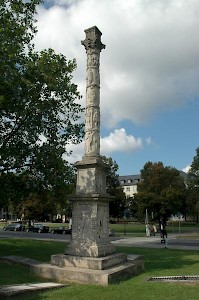
One of the best-known monuments of Mainz is a ten meter high column that was once dedicated to the supreme god Jupiter and mist have stood somewhere in the city. One must imagine a life-size statue of the god standing on top of it. The pillar was excavated in 1904-1905 near an ancient merchants' area, north of Mainz.
It had been smashed to pieces (more than two thousand) in Antiquity, and it is not an implausible hypothesis that the vandals were Christians who wanted to show that Jupiter was a false god. Later, the fragments were carefully buried, indicating that there were still people living in Mainze who appreciated the monument.
The monument on the first photo is a copy from 1934, not far from the Römisch-Germanisches Zentralmuseum. The original monument is in the Landesmuseum. From top to bottom, the remaining part consists of a cube that served as base of a statue; a Corinthian capital; the round shaft, decorated with all kinds of gods; the square pedestal, which consists of two parts, and is also decorated with deities.
In the upper part of the pedestal, you can read the dedication;note.
Iovi Optimo Maximo
PRO SALVTENERO-
NISCLAVDI CAE-
SARIS AVGusti IMPeratoris
CANABARI PVBLICE
Pvblio SVLPICIO SCRIBONIO
PROCVLO LEGato AVGvsti ;PRo PRaetore
CVRA ET IMPENSA
Qvinti IVLI PRISCI ET
Qvinti IVLI AVETI ( more...)
Which can be translated as
To Jupiter, greatest and best,
for the health of Nero
Claudius Cae-
sar Augustus, imperator,
by the cannabae community.
Publius Sulpicius Scribonius
Proculus was governor.
Made and paid for by
Quintus Julius Priscus and
Quintus Julius Avetus
The name of the emperor Nero proves that this inscription was made was made between 54 and 68; and that Nero was detested, is shown by the fact that someone made an effort to erase his name (damnatio memoriae, "condemnation of the memory"). The two Quinti Julii appear to have been some sort of decuriones, representatives of the civil settlement.
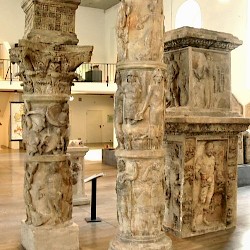 Mainz, Honorific column |
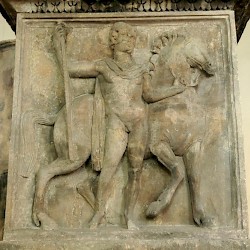 Mainz, honorific column, One of the Dioscuri |
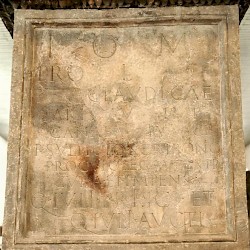 Mainz, Honorific column, Inscription |
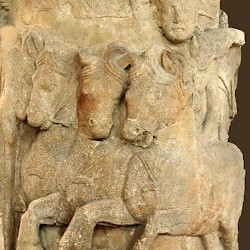 Mainz, honorific column, Helius |
The five drums of the column and two cubes of the pedestal are decorated by representations of, all in all, twenty-eight deities. The divine twins Castor and Pollux can be recognized, and you can easily spot Helius, who must have been identified to Mogon, the sun god after whom Mogontiacum may have been called.
On top of the column was the statue of the supreme god Jupiter. Some fragments survive and prove that it was made of bronze that was covered with gold leaf. If the sun was shining, the monument must have been visible from far away, and must have greeted the visitors, who knew that the end of their trip was -litteraly- in sight.
At the foot of the column, the two sculptors have written their names: Samus and Severus, the sons of a man with a native name, Venicarus.